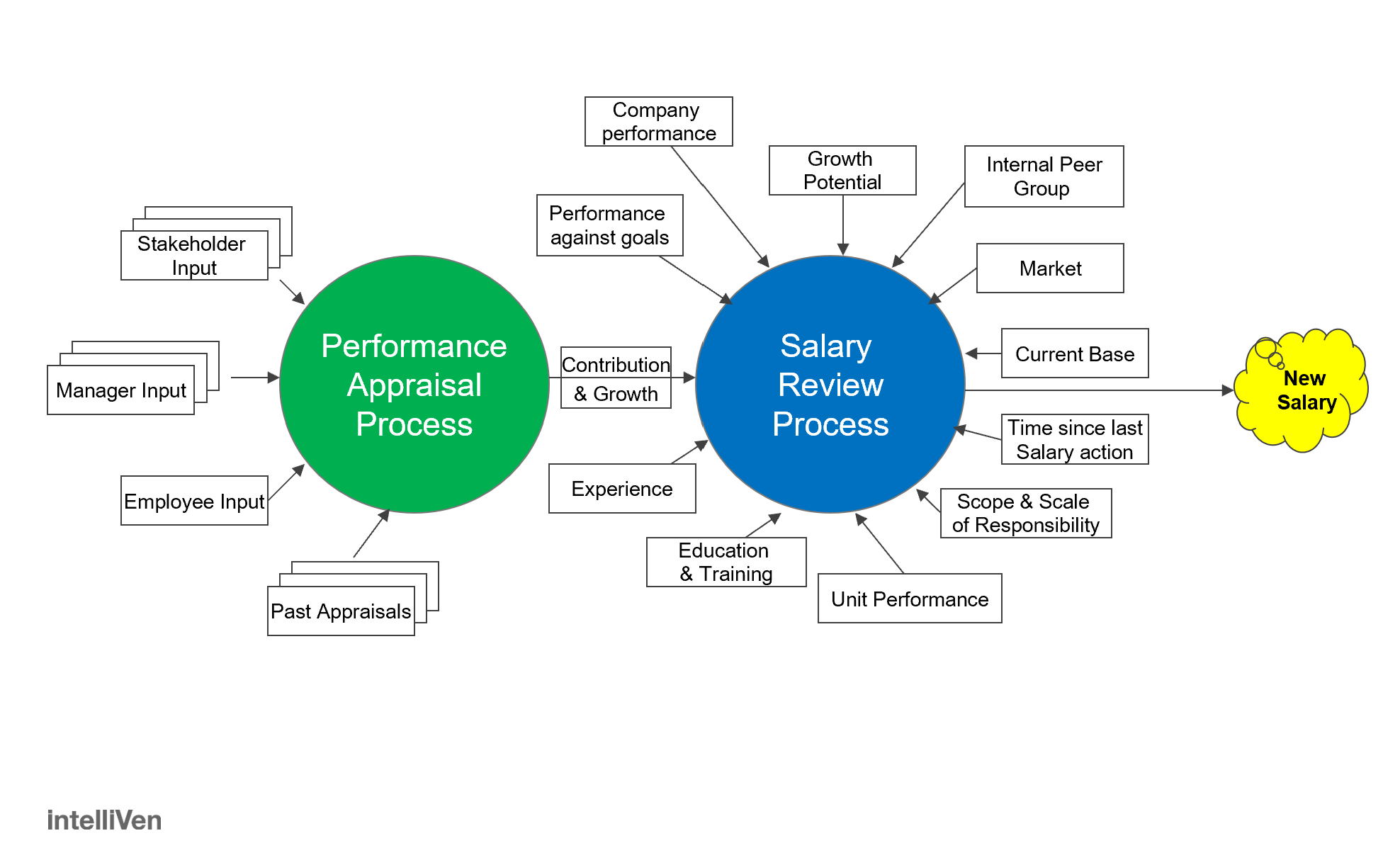 In order for an organization to grow, it is important for each person who works there to get and stay on track to career success. Towards that end, an annual appraisal process evaluates each employee’s performance and growth and provides employees feedback, guidance, and direction for development.
In order for an organization to grow, it is important for each person who works there to get and stay on track to career success. Towards that end, an annual appraisal process evaluates each employee’s performance and growth and provides employees feedback, guidance, and direction for development.
Less experienced leaders may count on managers to prepare and administer appraisals for those they supervise. Self-imposed pressure to “get the review right” can cause writer’s block and so it may be put off and eventually hastily pulled together with whatever comes to the manager’s mind at the time. Upon receiving such a review, employees may feel frustrated, confused, adrift, and not not at all known, appreciated, and guided towards success and career growth.
An effective appraisal process engages those who know and care about each employee on the subject of his/her strengths, contributions, growth, and areas for improvement. The reviewer identifies and works with reviewee stakeholders to collect input, consolidate, present to peers, iterate, and finalize a communication from the organization (not just from the reviewer) to the employee being reviewed.
Such an approach is called multi-rater, or a simple 360-degree review, because it collects data from multiple people who know and work with the reviewee. The process unearths a wealth of data from which to prepare a responsible appraisal, is relatively fast and easy to complete, and engages management in an effective review and guidance process that can be a major factor in driving employee and organization performance and growth.
Those involved in the appraisal process are depicted in Figure-1 and described below.
Reviewee: the person whose performance is being appraised.

Appraiser/Reviewer: the person who:
- Works with the reviewee to identify stakeholders.
- Solicits and collects input from stakeholders.
- Prepares a draft consolidated appraisal based on their own judgment and experience together with collected input.
- Shares the consolidated appraisal with peers in the Appraiser Review Meeting to ensure parity with peers and clarity on what should be the focus of the appraisal’s message.
- Revises the appraisal accordingly.
- Administers the completed appraisal in a one-on-one conversation with the reviewee.
Stakeholders: those with whom the reviewee works regularly and who therefore have a perspective from which to provide useful input to the appraisal. The following points apply:
- Appraisers work with reviewees to determine stakeholders from whom to request input.
- Shallow praise not backed up with supporting examples will be filtered out by the appraiser and/or the Appraiser Review Meeting and so should not be sought or provided.
- There can be any number of stakeholders that provide input. The ideal is to have only as many as are needed to provide a well-rounded assessment. Reviewees who work in many different modes with many different kinds of situations will likely need more stakeholders to get the full picture.
- It is not useful to get the same data from many sources but redundant input is easily ignored so it is okay to have one or two more than is needed at the minimum, but it is generally pointless to have too many stakeholders.
Appraiser Review Meeting: the forum at which reviewers meet to compare notes on consolidated reviews that are related in a meaningful way (e.g., all are developers or all are consultants or all are account managers or all are unit leaders, etc.).
Performance Appraisal Process Initiation
Core Leaders enlist someone from Human Resources to support and drive the process and then prepare and communicate a Time Line that spans about a month in which to:
· Solicit stakeholder input
· Complete Performance Appraisal Forms
· Conduct the Appraisal Review Meeting
· Administer Appraisals.
The HR coordinator assigns every employee a reviewer and a list of suggested possible stakeholders.
Core Leaders announce that the appraisal process has started.
Performance Appraisal Preparation
The performance appraisal process engages the community of people with a vested interest in a person’s growth in making explicit that:
- They know the person well,
- Appreciate the person for their contributions, and
- Have explicit suggestions that will guide the person to maximum growth and performance.
The following steps guide the preparation of the performance appraisal:
- The reviewer notifies reviewees that the appraisal process has started and works with each to identify his/her stakeholders; that is, people who are familiar with the reviewee’s work over the performance period and those who otherwise have a stake in their success.
- The stakeholders, reviewee, and reviewer each complete an Employee Appraisal Input Form distributed by the reviewer to summarize the reviewee’s strengths, contributions, and growth in the performance period just completed, and to identify opportunities for improvement in the next performance period. Stakeholders know the reviewee well and will likely have no trouble quickly filling out input the form with rich input. Avoid shallow praise and give detailed examples to bring points to light. Do not worry about careful editing or packaging which will be done later.
- Stakeholders submit completed Performance Appraisal Forms to the reviewer.
- The reviewer:
- Consolidates an appraisal based on stakeholder input, past appraisals, and assessments of actual performance against period goals.
- Destroys individual Performance Appraisal Forms other than the reviewee’s form.
- Distributes the consolidated appraisal form to attending managers by the day before the Appraiser Review Meeting.
Objectives of the Appraiser Review Meeting are to:
- Ensure consistency amongst and across managers and appraisals.
- Make sure that each appraisal represents what the organization as a whole has to share with each employee about their performance and not just the views of a single reviewer.
- Make managers are aware of how people in other parts of the organization are performing.
- Check-in on and upgrade the thinking and perspective of reviewers.
At the meeting each reviewer presents, in-turn, a two to three-minute summary of each reviewee, including the overall ratings for performance and growth as being below, at, or above expectation. If the reviewee being discussed is also a reviewer in the meeting, s/he leaves the room for discussion about their own performance.
The group discusses the reviewee for six to seven-minutes, adding additional points and challenging the draft appraisal. The goal is to arrive at a consensus on the one-to-three key messages the organization most wants to deliver in each section to the reviewee. Messages for each employee are captured to subsequently be incorporated into the final appraisal by the reviewer to reflect the collective managers’ input.
The managers in the Appraiser Review Meeting should all be of roughly the same executive level and should appraise only employees one or two levels lower than themselves.
The most senior leader in the Appraiser Review Meeting uses the forum to see what managers focus on and to profoundly impact their thinking and behavior relative to employee appraisal, review, guidance, and feedback. There is no better forum for leadership development than the appraisal review.
The process is repeated at as many levels as required to review every person in the organization.
The reviewer signs and dates the completed appraisal and then meets with the reviewee to administer the performance appraisal (See Exhibit H). The reviewer makes clear that what is communicated is from the organization as a whole and not from a single individual.
Performance Appraisal Administration
The following steps guide the administration of the performance appraisal:
The reviewer schedules an hour discussion with the employee being reviewed (the reviewee) at a convenient time and place to minimize the chance for distraction or disruption during the session.
Prior to the meeting the reviewer should let the reviewee know that the meeting is to cover annual performance appraisal and provide Tips for Reviewees. At the start of the meeting, the reviewer lets the reviewee know how much time is set aside for the discussion and generally behaves so as to put the reviewee at ease.
The reviewer walks through the reviewee’s self-evaluation and seeks to understand the employee’s perspective on him/herself and his/her performance. The reviewer pays close attention to what the reviewee has to say, practices assertive listening, and is diligent in efforts to show appreciation for the reviewee’s preparation, performance, and perspective.
The reviewer discusses the reviewee’s strengths, contributions, and growth, as well as the one or two areas to concentrate on next. The reviewer leans-in to any discomfort in order to convey the most important messages that the managers came up with.
It is important to NOT cover salary actions while administering theappraisal principally because it is impossible to do a good job discussing both performance and compensation in the same conversation. Once the meeting opens up the topic of compensation attention never returns fully to performance. The subject of salary is so electrifying that it dominates consciousness to the point of distraction. The better plan is for the entire process to be separate such that the output of appraisal is input to salary actions but separated in time as suggested by the illustration in the above figure.
The reviewer summarizes the meeting, and draws attention to the most positive aspects of the reviewee’s performance and reiterating again the key messages. The reviewee signs the document stating that the appraisal has been read, discussed, and understood.
The reviewer records notes on key points covered and adds reviewee’s comments to the consolidated appraisal if requested. If there were any significant disagreements, or if modifications to the appraisal are required, the reviewer shares them with those at the the Appraiser Review Meeting. The reviewer delivers the completed and signed appraisal to the HR coordinator for filing.
Why this Performance Appraisal Process works so well
The Performance Appraisal Process is a practical way to reveal to a person important things that are is known about him or her that s/he does not yet know about him/herself. It works in a manner consistent with what Organization Development theorists call the Johari Window. Review this note about the Johari Window from a leadership development class Dr. Hollander and Peter DiGiammarino designed and delivered for top students at the Commonwealth College of Massachusetts at UMass, Amherst to understand more about the connection between Johari Window and the Performance Appraisal Process.

